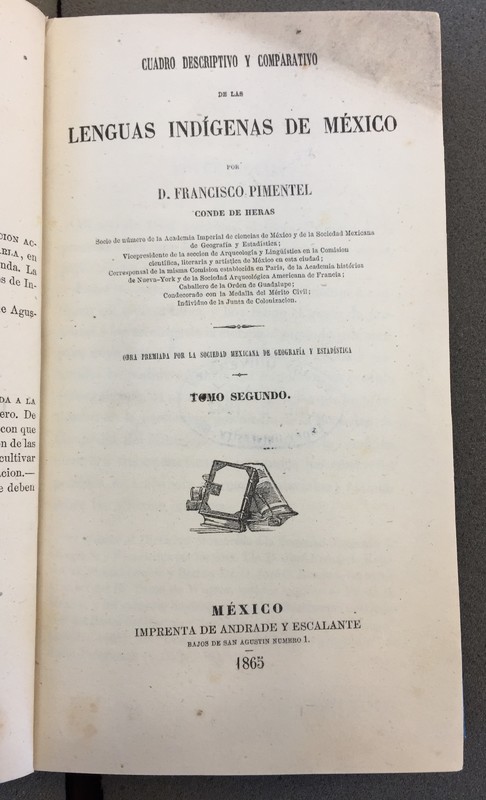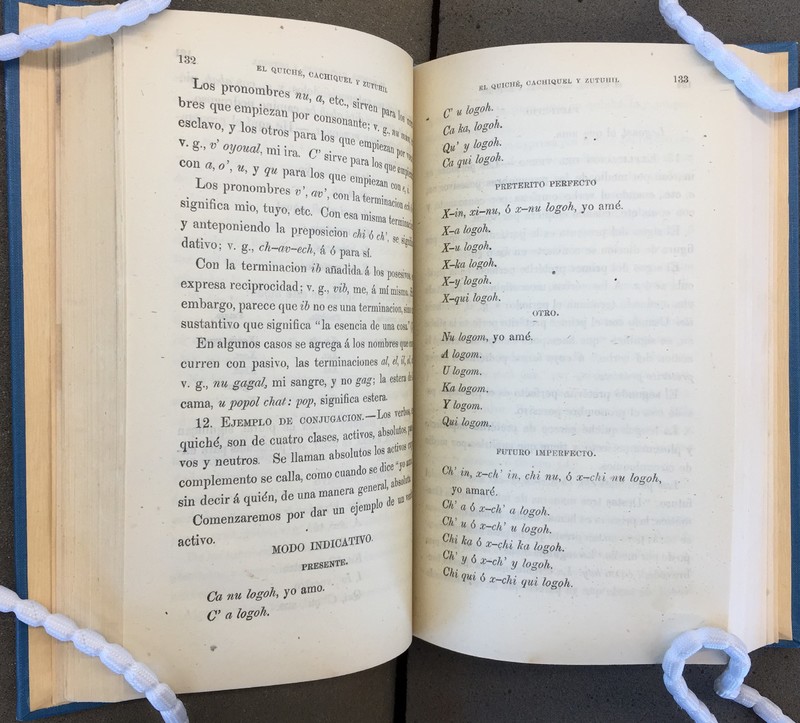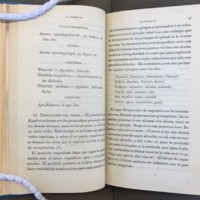Pimentel's Study of Indigenous Language: Indigeneity and the Mexican National Narrative
Mexican intellectual history can be characterized by a long tradition of studying indigenous peoples. These writings about indigenous groups by non-indigenous authors—an ideological paradigm that would come to be called indigenismo in Mexico—are often most associated with writers like Francisco Pimentel, Antonio García Cubas, and Jose Vasconcelos. This text, written by Pimentel and published in 1885, can be considered as part of this indigenist ideology. Pimentel’s book, Cuadro Descriptivo y Comparativo de Las Lenguas Indígenas de México [Descriptive and Comparative Volume on the Indigenous Languages of Mexico] is presented by the author as an objective study of the many native languages spoken throughout the Mexican nation. The book’s almost 400 pages are dedicated to in-depth discussions and formal linguistic analysis of the semantic and grammatical structures of more than 20 indigenous languages, including Yucateco, Quiché, and Comanche.
Pimentel’s book is divided into chapters corresponding to different languages, carefully discussing grammatical rules and basic vocabulary in each, offering practical translations to Spanish. However, each section begins with brief commentary over the indigenous communities and cultures themselves, oftentimes including sensationalized descriptions of native traditions and customs. In describing the indigenous groups whose languages he studies, Pimentel ends up echoing the distinction made by early Spanish colonizers between indios bravos [“angry Indians”] and indios amigos [“friendly Indians”]. For example, in discussing the Mixe people of Oaxaca, Pimentel emphasizes supposedly “primitive” qualities, such as cannibalism and nudity. These behaviors may well not have been true, but rather manipulated renderings made by Pimentel to paint indigenous Mexicans as in need of education and “civilization,” something that could only be attained through Christianity and European influence. Thus, while supposedly “objective” in nature, Pimentel’s Cuadro Descriptivo reflects elite, urban notions regarding national and cultural identity, and reveals indigeneity’s place within the Mexican national narrative.
Pimentel’s text forms part of the indigenist trend in which urban, elite Mexican intellectuals would study and publish on Mexico’s many indigenous communities, oftentimes positing indigeneity as a root of Mexican cultural and national identity. As Cuadros Descriptivos demonstrates, however, indigenous identities were often primitivized, often portrayed as backwards and uncivilized, in need of education and religion. Indeed, this was the very subject of Pimentel’s other writings, in which he argues that conversion and education are the only methods by which indigenous peoples can be drawn into “Mexican civility.”
Though his Cuadros Descriptivos text is supposedly “objective,” it is quite clear that Pimentel writes from the perspective of an urban elite that has internalized a colonial/imperial perspective on natives. This perspective echoes that of the conqueror-beast narrative presented in texts of the conquest, which posited the colonial encounter as one between the Spanish “conquerors” and indigenous “beasts.” This rendering of indigenous communities is not restricted to Pimentel’s text, but rather indicative of larger patterns in 19th century Mexican texts about indigenous peoples, or the indigenist trend more broadly.
-Chris Batterman
For further reading, see:
Beatriz Garza Cuarón, “Francisco Pimentel y La Lingüística Mexicana,” In Homenaje a Jorge A. Suarez: lingüística indoamericana y hispana, Beatriz Garza Cuarón and Paulette Levy, editors, pg 229-250 (Mexico City: Colegio de Mexico, 1990).
Guillermo Zermeño, “Del Mestizo al Mestizaje: Arqueologia De Un Concepto,” In El peso de la sangre: limpios, mestizos y nobles en el mundo hispánico, Nikolaus Bottcher, Bernd Hausberger, Max Hering Torres, editors, 283-318 (Mexico City: Colegio de Mexico, 2011).
Pimentel (Conde de Heras), Francisco. Memoria sobre las causas que han originado la situación actual de la raza indígena de México y medios de remediarla, Dos Obras de Francisco Pimentel. Mexico City: Consejo Nacional para la Cultura y las Artes, Cien de México, 1995.



